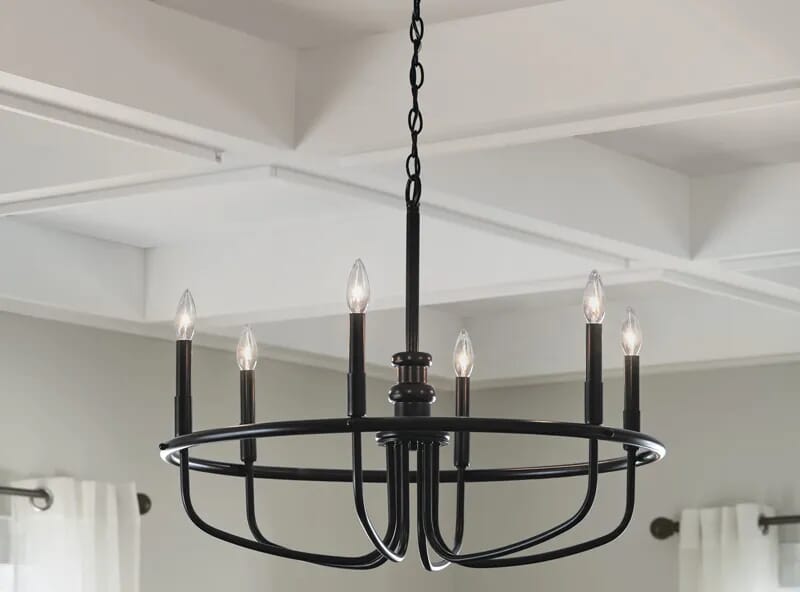Chandelier Buying Guide

The chandelier has been an ideal way to light a home for thousands of years. In fact, the earliest example of a chandelier is in the walls of French caves that were once inhabited by cavemen: there are holes in the walls because the cavemen needed a place to hang their torches. (You can also read more about the history of the chandelier. It's an interesting story!)
Chandelier design has, of course, evolved over the centuries and now there are more chandeliers available than ever before. Whether you want something ornate and traditional or something modern and unique, whether you need something big or small, there is a chandelier to fit your needs.
This buying guide will help you find your new favorite light by teaching you the basics about chandeliers. People tend to buy chandeliers to keep for about a decade, so this guide will help you make the best and most well-informed buying decision.
Chandelier Styles
These are the 3 most common chandelier styles.
Traditional: Probably what comes to mind when you hear the word: elegant, crystal-adorned fixtures that work best as a focal point because their ornate beauty demands your full attention. Today, traditional crystal chandeliers are available in a range of sizes and prices. Not every traditional chandelier has to have crystal.
Transitional: A midway point between traditional and modern styles. Transitional chandeliers generally aren't ornate, but aren't offbeat either. Straight lines, simple curves and sophisticated design define transitional chandeliers. Transitional light fixtures are versatile and designed to pair well with anything.
Contemporary: Contemporary chandeliers can take the shape of anything from a dazzling crystal confection to a space-age look. Common elements include clean lines, unique shapes and metallic finishes. Many contemporary chandeliers are also green, featuring elements like recycled materials, energy efficiency or LED lights.
Mini chandeliers, also known as chandelettes, are a great idea for adding chandelier beauty in rooms that are too small for traditional chandeliers. Like their larger counterparts, they run the gamut of decor styles from traditional to contemporary and more.
Because chandeliers are available in such a wide variety of shapes, sizes and styles, they can be used in practically any part of the home. There are special outdoor chandeliers, too!
Anatomy of a Chandelier

Loop: Connects the chandelier's chain to its body.
Column: The main structure of the chandelier.
Bulb: A chandelier's light source. Candelabra bulbs, which look like candle flames and are pictured here, are commonly used in chandeliers.
Candle Sleeve: A decorative and protective element designed to look like a wax candle.
Candle Cup: Holds the bulbs.
Bobeche: When chandeliers used actual wax candles, these pans played a crucial role--catching wax drippings so people didn't get hot wax dripped on them. While that's not an issue anymore, bobeches are still found in many chandelier designs.
Arm: Structures that hold the bulbs away from the chandelier column.
Finial: An ornament that often hangs alone at the bottom of the chandelier. Crystal finials are common.
Certain chandeliers, especially contemporary and modern styles, may not have all of these parts.
Sizing Chandeliers
Finding the right size for a chandelier depends on where you are going to use the fixture.
If you're going to use the chandelier above a table or island, measure the width or diameter of that area in inches. Then, look for chandeliers that are between 2/3 and 3/4 of that width or diameter.
If you're going to use the chandelier as general room lighting, measure the length and width of the room in feet, then add them together to find the ideal width of your chandelier in inches. (Example: An 8 foot by 10 foot room can be well-served by an 18-inch wide fixture.)
For rooms with lower ceilings, get a fixture that isn't too large or else the room will look like it's caving in. Higher ceilings can handle bigger fixtures. A chandelier with a complex design will look bigger than it actually is, so keep this in mind too.
The standard height for hanging a chandelier is 7 feet off the floor, but you can adjust this as necessary depending on the size of the fixture, the height of your room's ceiling, how tall the people in your home are and so on. (You can read more specific information about light fixture sizing.)
Chandelier Installation
Other Important Chandelier Information
If you need more advice about picking out your new chandelier, we have a helpful video! Some things to consider include the size of the room, the style of the room, your budget and what you want your chandelier to do.
Ready to shop? Browse our wide array of chandeliers now! Call us at 1-866-688-3562 or reach out on social media if you need more advice.
Emma Harger-Young - Lights Online
